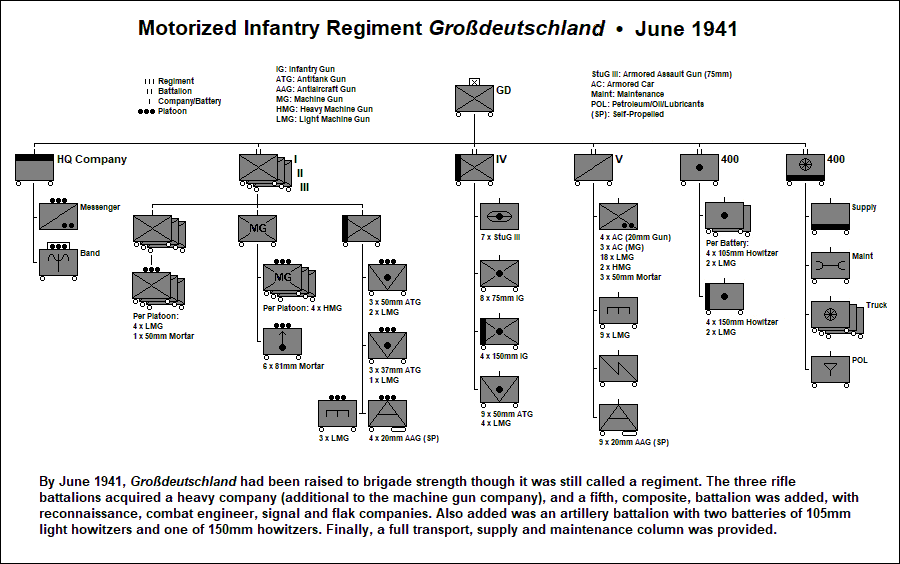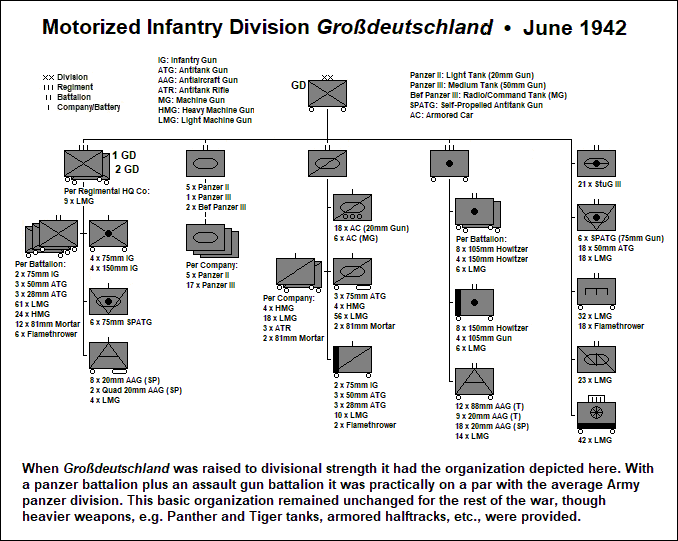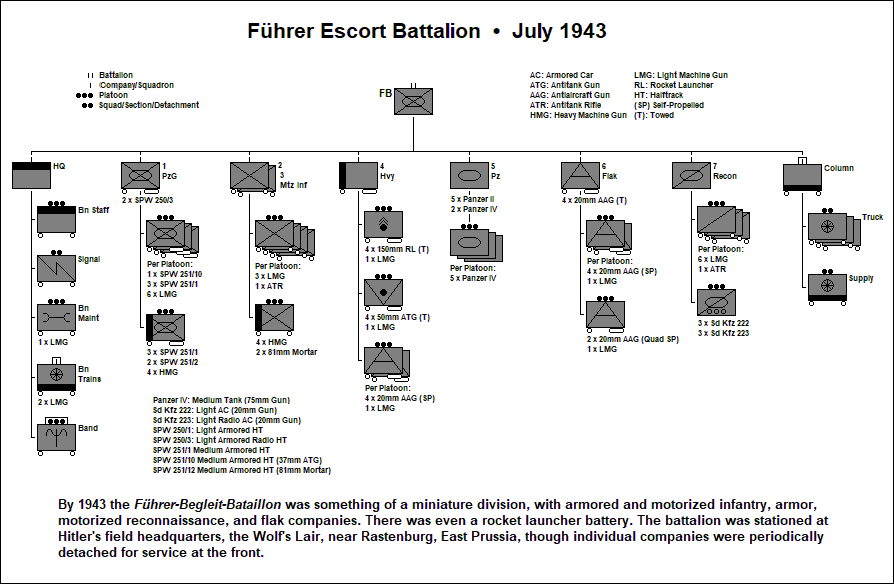Infantrie-Regiment
“Großdeutschland” (Infantry Regiment “Greater Germany”
or "G.D.") was the elite formation of the German Army, and
during World War II it was progressively expanded into a
brigade, a division and finally into an improvised panzer
corps of two divisions. Großdeutschland
was in effect the Army
counterpart and rival of the senior formation of the
Waffen-SS,
the Liebstandarte
SS Adolf Hitler, which
underwent a similar wartime expansion. Because its uniform
incorporated a cuff title similar to those worn by the
Waffen-SS,
Großdeutschland
is sometimes misidentified as an SS formation. It was,
however, a unit of the Army, albeit with special status.
Großdeutschland
originated as the Wach-Regiment Berlin
(Berlin Guard Regiment), a unit of the
Reichswehr
charged with the security of the government and national
capital plus ceremonial duties, somewhat
similar to the US Army’s 3rd Infantry Regiment (The Old
Guard) in Washington DC.
The Wach-Regiment
Berlin
was formed in early 1921, after the Kapp Putsch, an
unsuccessful attempt by right-wing factions to topple the
republican government and set up an authoritarian regime.
It it did not last long in its original form, being
disbanded in June 1921, but was soon replaced by the
Kommando der Wachtruppe
(Guard Troop Command) with similar duties.
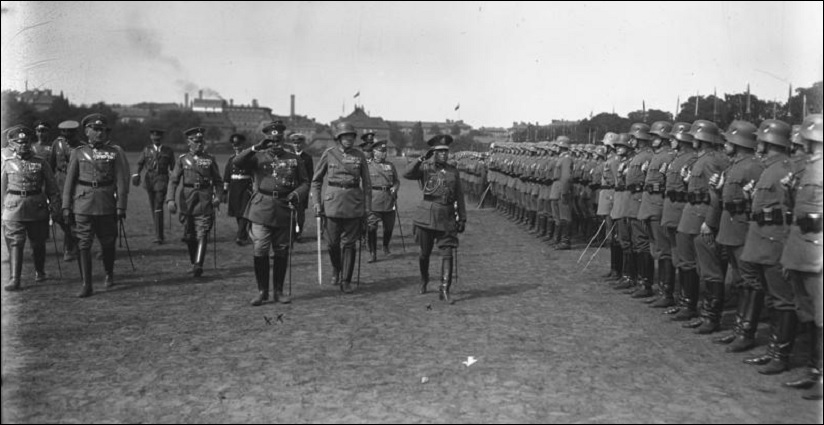
The Wachtruppe Berlin
being inspected by a visiting dignitary in 1929 (Bundesarchiv)
The reestablished Wachtruppe
consisted of seven companies, one from each of the seven
infantry divisions of the Reichswehr,
plus the Musikkorps der Wachtruppe
(military band). The companies were rotated in and out of
Berlin, serving a three months’ tour of duty; a small
command staff and the band were the only permanently
assigned units. When Hitler and his Nazi Party came to power
in January 1933 this arrangement was left in place. In 1934,
however, the unit’s name was changed to Wachtruppe
Berlin and in 1936,
after Hitler’s rearmament proclamation, it was expanded by
the addition of a headquarters and administration company.
In 1937 it reverted to its original name: Wach-Regiment
Berlin. By this time it
was the size of a battalion, various supply and
transportation elements having been added.
Traditionally the units of
the German Army had been raised and maintained on a
territorial basis. The country was divided into a number of
Wehrkreise
(Military Districts), each of which was responsible for the
peacetime command and administration of the Army units
stationed in its area. The Wehrkreise
were also responsible for
wartime mobilization and the raising of new units, whose
personnel, reservists and conscripts, were drawn from its
area. But the personnel of the reorganized Wach-Regiment
Berlin were specially
selected individual soldiers who served a six-month tour of
duty, thus representing the Army and the nation as a whole.
In January 1939, Hitler
ordered the Wach-Regiment
to be expanded to an actual regiment of three battalions
under a new name: Infantrie-Regiment “Großdeutschland,”
whose personnel were to
be recruited on a nationwide basis. It was officially
activated as such in June 1939 and was still undergoing
reorganization when the war began in September of that year.
Thus Großdeutschland
missed the Polish campaign, and it would have its baptism of
fire the following year in the invasion of France and the
Low Countries.
Großdeutschland
was organized as a motorized infantry regiment, thus bearing
the suffix (motorisiert).
Organizationally it was similar to a standard
motorized
infantry regiment, but
instead of regimental infantry gun (IG) and antitank gun (ATG)
companies it had a fourth “heavy” battalion of four
companies: assault gun (StuG III assault guns), light IG (75mm), heavy IG
(150mm), and ATG (37mm).
Großdeutschland
was one of the first units to be equipped with the StuG
III, which was to become Germany’s second-most produced armored
fighting vehicle of the war.
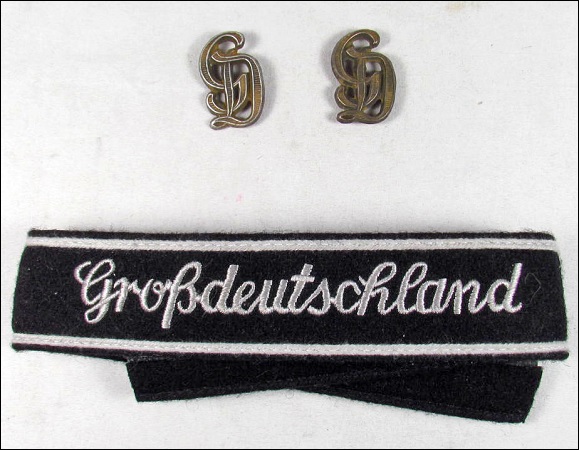
Monograms
badges
and cuff title of Infantrie-Regiment "Großdeutschland"
The cuff title is one of several different
styles that were worn at different times. The
monogram badges were worn on officer and NCO shoulder straps. (iCollector.com)
For the 1940 campaign in
the west, Großdeutschland,
less its III Battalion, was assigned to XIX Motorized Corps,
Panzer Group von Kleist, Army Group A, and was attached to
the 10th Panzer Division. The III Battalion was detached to
participate in airborne operations in Belgium, its troops
being carried into action by light aircraft. Between 15 and
17 May, the regiment was involved in heavy fighting around
the village of Stonne on the Meuse River, the village
changing hands seventeen times before the French defense
collapsed. Großdeutschland
suffered 570 casualties in this battle. Next came the Battle
of Arras, another sharp action in which a British armored
counterattack was parried. The regiment then advanced to the
Dunkirk perimeter and after the British evacuation it was
transferred south to participate in the second phase of the
campaign—in the course of which some of its troops massacred
a number of captured black soldiers and their French
officers.
After the French
capitulation, Großdeutschland
was moved to the south of France in preparation for
Operation Felix, the planned occupation of Gibraltar. When
this was canceled the regiment was transferred to XXXXI
Motorized Corps, First Panzer Group, Twelfth Army, for the
Balkan campaign (April 1941). Thanks to the swift collapse
of the Yugoslavian Army, Großdeutschland
was not heavily engaged—though once again some of its troops
were involved in a war crime, this time the reprisal
shooting of 35 civilians.
In preparation for
Operation Barbarossa, the invasion of the Soviet Union,
Großdeutschland was
expanded to brigade size, though it continued to be called
a regiment. A fifth composite battalion with
reconnaissance, engineer, flak (antiaircraft) and signal companies was
added, along with an artillery battalion—the latter with 8 x
105mm light howitzers and 4 x 150mm howitzers. The three
rifle battalions acquired a heavy company (additional to the
existing machine gun company) with two AT platoons, a light
flak platoon and an engineer platoon. Finally, the supply
column was expanded to battalion size.
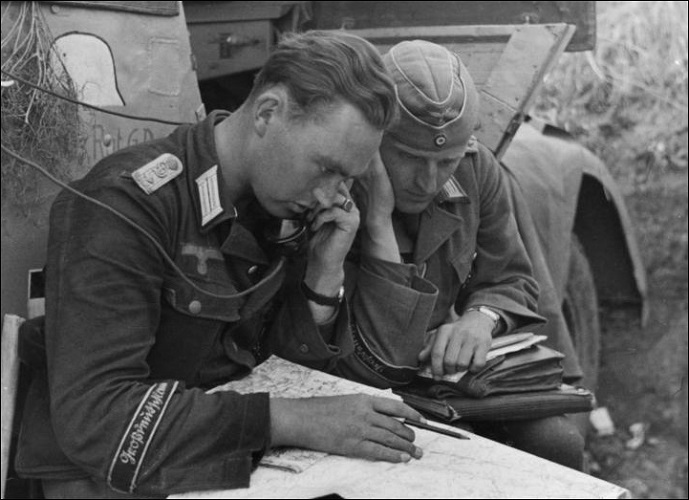
Officers
of Großdeutschland, circa 1942. Note
the cuff titles and the shoulder strap
monogram. Visible behind the officer in the
foreground is the division's tactical sign:
a steel helmet (Stalhelm) in outline.
(Bundesarchiv)
For the initial stage of
Barbarossa, Großdeutschland
was assigned to the XXXXVI Motorized Corps, Second Panzer
Group, Army Group Center. The regiment suffered heavy
casualties from June to November 1941, and lost even more
heavily during the Red Army's 1941-42 winter counteroffensive. By
late February, Großdeutschland
had been reduced to the strength of a single battalion, and
shortly thereafter it was taken out of the line for rest and
reorganization.
During March and April 1942
Großdeutschland was
raised from brigade to divisional strength, becoming
Infantrie-Division “Großdeutschland” (motorisiert)
with two infantry regiments, an artillery regiment, a panzer
battalion, an assault gun battalion, motorized
reconnaissance, AT and engineer battalions, and full divisional services. All sub-units were identically
identified, e.g. Panzer-Abteilung
“Großdeutschland";
only the two infantry
regiments bore numbers. In October 1942 when all Army
infantry regiments were renamed grenadier regiments, they
shed their numbers, becoming Grenadier-Regiment
Großdeutschland
and Füsilier-Regiment Großdeutschland—traditional
titles recalling the army of Frederick the Great.
Though it retained its infantry identity, the new
Großdeutschland
division was equipped almost on a par
with the
panzer divisions.
In this form it participated in the summer 1942 offensive in
southern Russia, again suffering heavy casualties. By the
time the Stalingrad debacle had run its course,
Großdeutschland
had lost so heavily as to be rendered combat ineffective.
Sufficient manpower and material replacements were
subsequently received to enable the division to participate
in the successful February-March counteroffensive that
recaptured the key city of Kharkov. It was then taken out of
the line for rebuilding.
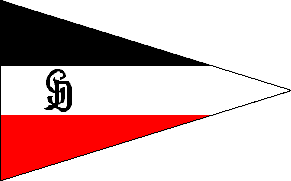
Command Flag of the
Großdeutschland Division 1942-45
By May 1943
Großdeutschland was
back up to strength, having received picked manpower and the
latest equipment in preparation for the Battle of Kursk, For
Operation Citadel, as the Kursk offensive was code-named,
the division was assigned to the XXXXVIII Panzer Corps,
Fourth Panzer Army, Army Group South. By then it had been
retitled Panzergrenadier-Division
“Großdeutschland,”
its two infantry regiments
receiving the titles Panzergrenadier
and Panzerfusilier.
By this time one battalion of the Panzergrenadier
regiment was equipped with armored halftracks instead of
trucks, and the divisional order of battle included a heavy
panzer company with Panzer VI (Tiger) tanks.
After the premature
termination of Citadel, in which it suffered significant
casualties, Großdeutschland
was employed as a mobile reserve during the 1944-45
defensive battles on the Eastern Front. In March 1944, the
OKH ordered the creation of Panzerkorps “Großdeutschland,”
which was supposed to
consist of two divisions plus the usual corps troops. In fact
the corps was cobbled together with various odds and ends,
including the staff of the dissolved 18th Artillery Division
and remnants of the
dissolved XIII Corps. The additional division was the new
Panzergrenadier-Division “Brandenburg.”
However, the corps never actually fought as a unit and in
the last months of the war Großdeutschland
shrank to a strength of some 4,000 men. Most of them
surrendered to the Red Army, though around 800 were able to
make their way west, surrendering to the British Army in
Schleswig-Holstein.
There were a number of
other Army units associated with Großdeutschland.
One was the
Wach-Regiment Berlin,
which was reestablished early in the war to provide security
in and around the capital. This unit and its commander,
Major Otto Remer, played a key role in the suppression of
the July 20 putsch attempt by dissident Army officers.
Another was the Führer-Begleit-Bataillon
(FBB; Escort
Battalion of the National Leader). Raised in early 1939, its
mission was to provide security for Hitler when he was
traveling near the front or was resident in his East
Prussian field headquarters. In
1943 the FBB was joined by the Führer-Grenadier-Bataillon
(FGB) with similar
duties and ultimately both formations were raised to brigade
strength and participated in the Ardennes offensive (Battle
of the Bulge) in late 1944-early 1945. By the end of the war
they had divisional status, but probably neither ever had
more than the strength of a brigade.
Right to the end and despite the heavy casualties it repeatedly suffered,
Großdeutschland
maintained its status as an elite unit. Like the
Waffen-SS it received
the pick of available replacements and the latest available
equipment, and its combat record was indeed impressive. But
like the German Army as a whole, that record was stained
with the guilt of atrocities committed against prisoners of
war and civilians. If these were not as extensive and
bestial as those perpetrated by the SS, they should
nevertheless be borne in mind when assessing
Großdeutschland’s
legacy.






